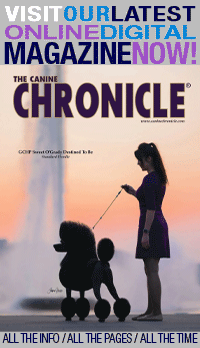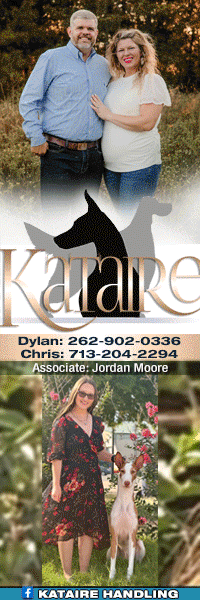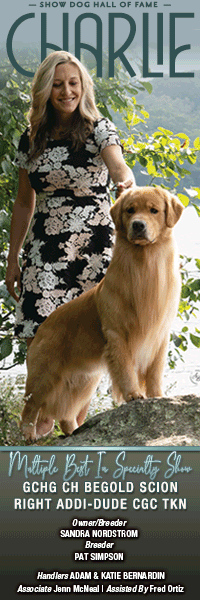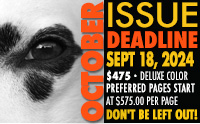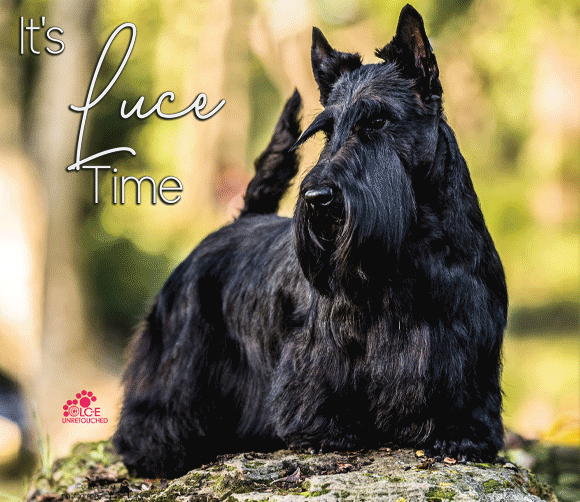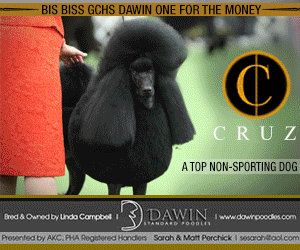From The CC Vault: A Certain Specifying Function
by Gareth Morgan-Jones
Originally published: November 2012
 Whilst recently preparing to conduct Provisional/Permit assigments in a number of Sporting breeds, the occasion arose to once more thoroughly review their respective standards. Yet again something really stood out like a sore thumb. Call it an incongruity or a notable lack of consistency in terms of the degree of specification contained therein. These man-composed instruments, which are so pivotal to our understanding and which we make such a big deal of in the sport, still vary a great deal in the amount of detail which they contain and breeders, as well as judges, are still expected to interpret, to various extents, what is meant by the provided descriptions. Some have remained unchanged over the years whilst others have been repeatedly reworked, modified and augmented. As a result, some remain sparse, somewhat vague and open, whilst others are so hyper-inflated as to render them overly-loaded and, hence, unduly cumbersome with a whole lot of word-usage redundancy. In their composition the common aim has been to accurately document those characteristics which are specific to particular breeds but yet we have this considerable disparity in content, clarity and length. The range extends from barely adequate to gross overkill. How come, one might well ask? Do they all fulfill their required function equally well, despite the varying extents of specification, or are some still lacking adequate particularization? When a standard contains no mention of body proportions, for example, and some do fall into this category, whilst another is so exact as to disallow even a slight variation in this regard, what should one make of it?
Whilst recently preparing to conduct Provisional/Permit assigments in a number of Sporting breeds, the occasion arose to once more thoroughly review their respective standards. Yet again something really stood out like a sore thumb. Call it an incongruity or a notable lack of consistency in terms of the degree of specification contained therein. These man-composed instruments, which are so pivotal to our understanding and which we make such a big deal of in the sport, still vary a great deal in the amount of detail which they contain and breeders, as well as judges, are still expected to interpret, to various extents, what is meant by the provided descriptions. Some have remained unchanged over the years whilst others have been repeatedly reworked, modified and augmented. As a result, some remain sparse, somewhat vague and open, whilst others are so hyper-inflated as to render them overly-loaded and, hence, unduly cumbersome with a whole lot of word-usage redundancy. In their composition the common aim has been to accurately document those characteristics which are specific to particular breeds but yet we have this considerable disparity in content, clarity and length. The range extends from barely adequate to gross overkill. How come, one might well ask? Do they all fulfill their required function equally well, despite the varying extents of specification, or are some still lacking adequate particularization? When a standard contains no mention of body proportions, for example, and some do fall into this category, whilst another is so exact as to disallow even a slight variation in this regard, what should one make of it?
The fact that standards have been either left well enough alone or constantly revised over time by different individuals or groups has inevitably led to the situation in which we find ourselves today. There have obviously been philosophically differing opinions at play and this has resulted in a self-evident, highly unevenness of approach. The result is there for all to see. One of the factors involved in all of this, of course, involves the derivative nature of many of these instruments. There is not a whole lot of originality in most of them, the majority having oftentimes been put together piecemeal, bit by bit, their composition accomplished by the assembly of fragments often derived from previously existing ones. Hence the frequent spillover of jargon peculiarities. So in what sort of context should we view breed standards? It almost goes without saying that they are meant primarily to be as accurately descriptive of breed characteristics as possible, whilst allowing for a certain degree of naturally occurring variation. But how are we to determine how well or otherwise the goal of adequate specification is being met? By the condition of breeds, by the degree of variation seen within them at any one time? By attempting to match, to contrast and compare, that which is being imagined and idealized to actual reality? Insofar as their primary use is concerned, and I’m stating the very obvious here, the essential function of standards is to provide a specific enough means of maintaining a breed in a certain place, in a particular condition.
As I suggested in a previous essay published in The Canine Chronicle, several years ago now, standards essentially serve an anchoring, as well as a specifying, function in the short, as well as long, term. That is surely why, whenever we set out to change them, for whatever purpose, great care has to be taken lest this object be defeated by compromising the mooring and rendering them less secure. There can be little doubt that those original, open, concise, essentially brief, clean, spare standards, which we still, perhaps remarkably, have for some of the older breeds even today, have stood us in very good stead indeed; they have assuredly weathered the test of time. So why, one might well ask, are there not more of them still in use? Have they really been that inadequate and have the breeds which they describe suffered as a result? Hardly so is probably the right answer to this question. Is it not possible to be brief but yet be adequately comprehensive? But what of the rest, those we have repeatedly and extensively tampered with over the years and are still in the process of being modified, for whatever reason? Are the breeds any better off and in more superior, not to say uniform shape, than they might otherwise have been because of having these long-winded, highly-verbose, overly-particularized standards? Are they necessarily better served? When do we reach the more-than-enough-words stage; when do we reach the point of diminishing returns in all of this? It is abundantly clear that there are those among us who hold the firm belief that the more detailed a standard is the more effective it fulfills its multiple functions. But is this necessarily true? Is there a sort of disconnect here between reality and some abstract idea or notion? It so happens that two of the breeds which I was recently judging for the first time could not have been more different in regard to their standards. One has an extremely long one, with highly excessive verbiage, a veritable profusion of words, the other is quite brief and to the point. Guess what? In sizeable entries, the breed having the severely bloated standard showed much more variation in form and type! A message perhaps.
There are some basic truths that we have to consider in this context. The first is that the breeds came first and the standards followed, not the other way around. Man did not initially write a standard and then go about the business of breeding a dog to exactly match it. Some entities have, of course, been recreated but their form had to have preexisted before a description thereof could be accurately fashioned. So you have the original breeds and you have the original standards. Then there has followed the development part of the story and this is where the waters get quite badly muddied and the subject gets complicated. This is where some of the diversity of opinion concerning standards originates and this is where the dichotomies in quality and validity of same stem from. Although standards are often viewed as being somehow sacrosanct, as being inviolable, they are, of course, nothing of the sort, at least historically speaking. Nevertheless, it is not unreasonable to argue that they should be regarded as being above and beyond alteration unless there is some very good reason, such as gross inaccuracy or dire inadequacy, for such action. Here is a very basic question. Should standards be constantly revised and altered in response to breed changes or should this be stringently resisted and avoided because, in essence, the anchoring mission is thereby automatically compromised? In many breeds, of course, this has happened and successive revisions have as much, if not more, to do with accommodating change in morphology as they do with attempting more adequate description. Have there been instances where things have happened in reverse, where someone’s notion of a perfected and ideal form has come first and has been incorporated in a standard before it has actually existed in reality? Have there indeed been cases where rewording standards in one respect or other has led to subsequent changes in the breeds themselves? Perhaps so, perhaps not. This is not the sort of thing that is readily provable; it surely belongs in the speculative sphere of things. Some standards, particularly those of one or two of our more recently recognized breeds with which I am familiar, appear even fanciful for few, if any, of the exhibits at our shows come within reasonable distance of matching the dictates contained in their descriptions. This, incidentally, makes it rather hard on judges and you get widely differing opinions! These are all rather fascinating questions and any meaningful dialogue concerning standards has to take them into account.
So where are we with all of this? In a muddle or is there some rhyme or reason as to how we collectively view and apply standards? You hear all this erudite talk of the responsibility of breeders to breed to the standards and the obligation of judges to adjudicate by them. Some of this almost appears to be an abstraction, divorced from reality. But just how far are these ideals being met? Again, is there some disconnect between what is being idealized and the state of things in actuality? And while we are on this subject, how successful have we really been in making the standards the best they can be in terms of utility? The record is highly uneven, which perhaps also accounts, in part, for the fact that there apparently exists this incessant tendency to think improvement and a conviction that we can do better. Making them longer doesn’t necessarily do it. On the contrary, in some respects, those excessively worded descriptions are more burdensome than they are constructive and useful. Seems like we want to improve breeds and improve standards without end: a singularly strange psychology. We arrive at this frame of mind without giving adequate consideration to certain restrictive factors. There is the limitation of language usage for a start. There are so many examples of repeated attempts at refining descriptions but in fact nothing much is being achieved that was not already there. At a certain stage it becomes a superfluous exercise. We are still using words like ‘somewhat’ and ‘slightly’ to qualify because there is no alternative way of conveying a meaning beyond numerical specification as, for example, in the case of length versus height. When we say “somewhat” it translates into in some measure, to some extent. The question then becomes how much? “Slightly” means in small amount, but the quantification is inherently imprecise.
The message here, it seems to me, and I know there are some who will disagree on this, is that the less often we tamper with standards, the better off we probably are. I am using the operative word in the last sentence purposefully. Changing or adding words oftentimes, even though the reasoning behind such action may be perfectly legitimate, may not achieve, perhaps surprisingly, an intended purpose or have the desired affect. Although this sounds defeatist there is, I believe, a measure of realism here. We liken standards to blueprints, something which they cannot possibly be in a complete, strict sense. I am perfectly aware, of course, of fanciers out there who are concerned that their breeds are inexorably drifting away from their original forms and are convinced that the one sure way to counter this undesirable trend is to vastly increase and strengthen the wordage and, thereby, hopefully enhance the anchoring potential. This may or may not work but a much better way of assuring the maintenance of breed form and type in all its aspects is to properly educate successive generations of breeders. The problem is that when changing standards becomes a habitual activity in the culture of the sport, it opens the door to misuse and to that which is counterproductive, with the end result of breed integrity being potentially adversely impacted and the utility of standards being lessened.
Short URL: http://caninechronicle.com/?p=277233
Comments are closed
